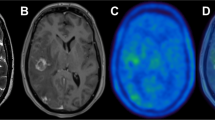Summary
PET is a new method in nuclear medicine which examines the metabolism and not the morphology. Tumors show a higher rate of glycolysis than benign tissue and hence can be detected by radioactive glucose. This method has proved good for various tumors. In this study the lymph node staging of bladder cancer by PET was investigated. In 64 patients a PET of the pelvis after injection of fluorodeoxyglucose (FDG) was carried out preoperatively; the PET-results were compared with the histology of the OR specimen after classical pelvic lymphadenectomy. For lymph node staging positive nodes were found in 14 patients which was correct; a false-negative result was obtained in 7 patients. In 37 patients the PET-result was true-negative and in 6 patients false-positive resulting in a sensitivity of 67 %, a specificity of 86 % and an accuracy of 80 %. Therefore, our PET results are encouraging and seem to be better than those obtained by classical staging procedures such as CT or MRI.
Zusammenfassung
Die Positronenemissionstomographie (PET) stellt ein neues bildgebendes Verfahren dar, mit der Stoffwechselvorgänge und nicht morphologische Veränderungen untersucht werden können. Da Tumoren eine erhöhte Glykolyse aufweisen, können diese mittels radioaktiv markierter Glukose und PET nachgewiesen werden. Dieser Ansatz hat sich bereits bei unterschiedlichen Tumorentitäten bewährt. In dieser Studie wurde die PET beim Lymphknotenstaging des Harnblasenkarzinoms untersucht. Bei 64 Patienten wurde präoperativ eine PET des Beckens nach i. v.-Injektion von Fluor-Deoxy-Glukose (FDG) durchgeführt, so daß der PET-Befund mit dem histologischen Befund des Operationspräparates nach klassischem operativen Lymphknotenstaging verglichen werden konnte. Beim Lymphknotenstaging wurden bei 14 Patienten positive Lymphknoten richtig erkannt; ein falsch-negatives Ergebnis trat bei 7 Patienten auf. Bei 37 Patienten wurden die Lymphknoten als richtig-negativ bewertet, 6mal war ein falsch-positives Ergebnis erzielt worden. Aus diesen Daten errechnet sich eine Sensitivität von 67 %, eine Spezifität von 86 % und eine Treffsicherheit von 80 %. Somit sind die PET-Ergebnisse ermutigend und scheinen besser zu sein als die klassischen Stagingverfahren, wie CT und MRT.
Similar content being viewed by others
Author information
Authors and Affiliations
Rights and permissions
About this article
Cite this article
Bachor, R., Kotzerke, J., Reske, S. et al. Lymph node staging for urinary bladder carcinoma with positron emission tomography (PET). Urologe 38, 46–50 (1999). https://doi.org/10.1007/s001200050244
Published:
Issue Date:
DOI: https://doi.org/10.1007/s001200050244




